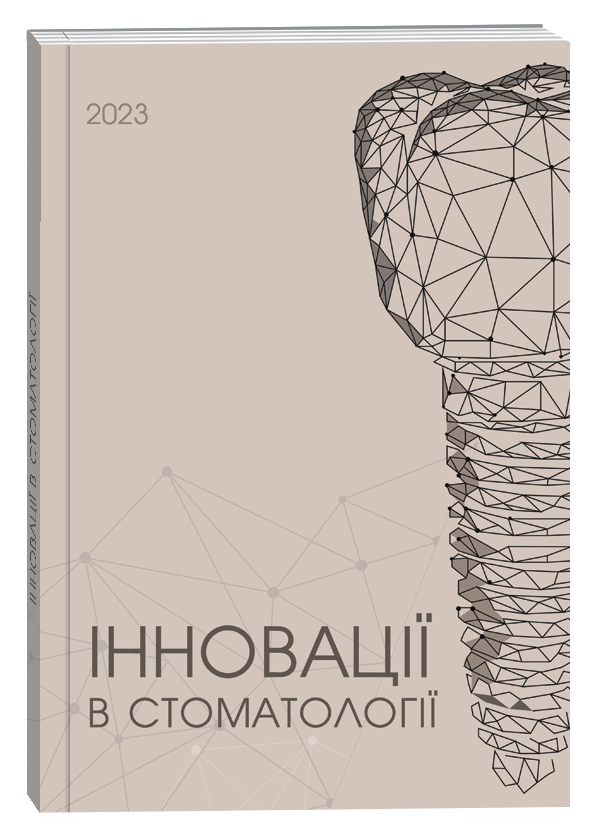TEMPOROMANDIBULAR DISC RECAPTURE AND ITS EFFECT ON THE TMJ BONE ELEMENTS
DOI:
https://doi.org/10.35220/2523-420X/2024.4.13Keywords:
temporomandibular disc reposition, reposition splint, cone-beam computed tomography, magnetic resonance tomographyAbstract
The aim of the study: to show the effectiveness of the sequential use of two techniques (the author’s technique for the manufacture of a deprogramming device on the upper jaw and the manufacture of a reposition splint on the upper jaw) for the treatment of the temporomandibular joint (TMJ) by its reposition, and to assess their long-term effectiveness in the remodeling of bone and soft tissue elements of the TMJ by conducting control diagnostic cone-beam computed tomography TMJ (TMJ CBCT) and TMJ magnetic resonance imaging (TMJ MRI) before and after DMJ reposition. Materials and methods: The examinee applied to the Department of Orthopedic Dentistry, Digital Technologies and Implantology, Faculty of Dentistry of the Shupyk National Health University of Ukraine. In the process after filling out the normative consent and familiarizing himself with the examination plan (approved by the Commission on Ethics and Academic Integrity of the Shupyk National Health University of Ukraine (protocol No. 13/10), a clinical examination of the patient was carried out with TMJ CBCT, TMJ MRI, the manufacture of a deprogramming device for a period from 7 to 10 days (wearing mode: 2-3 hours a day). Scientific novelty: The study proposes a new comprehensive approach to the treatment of DDWR, based on deprogramming the masticatory muscles before the use of anterior reposition devices (ARA). This method provides a reduction in symptoms and a significant improvement in the structural characteristics of the joint, which is presented in this clinical case. Reduction of pain, discomfort and other symptoms associated with DDWR. The technique also helps to restore the physiological position of the disc and reduce degenerative changes in the joint. Long-term treatment results have been confirmed by numerous clinical studies and MRI diagnostics, indicating sustained improvements in the condition of patients with DDWR. Conclusions: The study confirmed the high efficiency of the sequential use of two techniques for the treatment DDWR of the TMJ. The use of our proposed method of treatment with the sequential use of a deprogramming device and a repon guard on the upper jaw contributed to the reduction of the dTMJ and the improvement of bone and soft tissue elements of the TMJ. Control and diagnostic images using cone-beam computed tomography (CBCT) and magnetic resonance imaging (MRI) confirmed the long-term effectiveness of the methods used. The treatment effectively reduced pain, discomfort and other symptoms associated with the TMJ and contributed to the restoration of the physiological position of the dTMJ, as well as the reduction of degenerative changes in the joint.
References
Sato S., Slavicek R. The masticatory organ and stress management. J. Stomat. Occ. Med. 2008. № 1. C. 51–57 URL: https://doi.org/10.1007/s12548-008-0010-8
Lipton, J. A., Ship, J. A., & Larach-Robinson, D.. Estimated prevalence and distribution of reorted orofacial pain in the United States. Journal of the American Dental Association. 1993. № 10. С. 115–121. URL: https://doi.org/10.14219/jada.archive.1993.0200
Valesan, L. F., Da-Cas, C. D., Réus, J. C., Denardin, A. C. S., Garanhani, R. R., Bonotto, D., Januzzi, E., & de Souza, B. D. M., Prevalence of temporomandibular joint disorders: a systematic review and meta-analysis. Clinical oral investigations. 2021. № 2. С. 441–453. URL: https://doi.org/10.1007/s00784-020-03710-w
Ohrbach, R., & Greene, C. Temporomandibular Disorders: Priorities for Research and Care. Journal of dental research. 2022. № 7. С. 742–743. URL:https://doi.org/10.1177/00220345211062047
Zieliński, G., Pająk-Zielińska, B., & Ginszt, M., A Meta-Analysis of the Global Prevalence of Temporomandibular Disorders. Journal of clinical medicine, 2024, № 5, С. 1365. URL:https://doi.org/10.3390/jcm13051365
Штибель Д.В., Сучасні погляди на етіологію, клініку, діагностику зміщень дисків і запально-дегенеративних хвороб СНЩС. Український стоматологічний альманах. 2023. № 3. С. 60-65. URL: https://doi.org/10.31718/2409-0255.3.2023.10
Дрогомирецька М. С. Клінічна нейром’язова діагностика та профілактика ускладнень при лікуванні вивиху диска СНЩС. Сучасна стоматологія. 2018. № 3 С. 78-85. URL: https://doi.org/10.33295/1992-576X-2018-3-78-85
Жегулович, З.Є., Етніс, Л.О., & Саяпіна, Л.М., Основні тенденції дослідження патології скронево-нижньощелепного суглобу в Україні. Актуальні проблеми сучасної медицини: Вісник Української медичної стоматологічної академії. 2023. № 23(1). С. 170-177. URL: https://doi.org/10.31718/2077-1096.23.1.170
Рибалов О. В., Новіков В. М., Яценко П. І., Іваницька О. С., Коросташова М. А Рентгенологічні характеристики дисфункції СНЩС. Вісник проблем біології і медицини. 2019. № 4. С. 335-340. URL: http://dx.doi.org/10.29254/2077-4214-2019-4-1-153-335-338
Garcia, A. R., Folli, S., Zuim, P. R., & de Sousa, V., Mandible protrusion and decrease of TMJ sounds: an electrovibratographic examination. Brazilian dental journal. 2008. № 1. С. 77–82. URL:https://doi.org/10.1590/s0103-64402008000100014
Лунькова Ю.С, Тумакова О.Б., Новіков В.М. Симетричність динамічних змін суглобових дисків при внутрішніх розладах СНЩС за даними МРТ. Український стоматологічний альманах. 2017. № 2. С. 31-35. URL: https://dental-almanac.org/index.php/journal/article/view/259
Новіков, В.М., Горбаченко, О.Б., Резвіна, К.Ю., Коросташова, М.А. Статистичний аналіз поширеності внутрішніх розладів скронево-нижньощелепних суглобів у пацієнток на основі класифікації C. H. Wilkes. Актуальні проблеми сучасної медицини: Вісник Української медичної стоматологічної академії. 2024. № 2. С. 87-91. URL: https://doi.org/10.31718/2077-1096.24.2.87
Sá, M., Faria, C., & Pozza, D. H., Conservative versus Invasive Approaches in Temporomandibular Disc Displacement: A Systematic Review of Randomized Controlled Clinical Trials. Dentistry Journal. 2024. № 8. С. 244. URL: https://doi.org/10.3390/dj12080244
Klasser GD, Greene CS. Oral appliances in the management of temporomandibular disorders. Oral Surgery, Oral Medicine, Oral Pathology, Oral Radiology, and Endodontics. 2009 № 2 С. 212-223. URL: https://doi.org/10.1016/j.tripleo.2008.10.007
Simmons H.C., Gibbs S.J., Recapture of temporomandibular joint disks using anterior repositioning appliances: an MRI study. CRANIO®. 1995. № 4 С. 240–246. URL: https://doi.org/10.1080/08869634.1995.11678073
Simmons, H. C., 3rd, & Board of Directors, American Academy of Craniofacial Pain. Guidelines for anterior repositioning appliance therapy for the management of craniofacial pain and TMD. Cranio : the journal of craniomandibular practice. 2005. № 4. С. 300–305. URL:https://doi.org/10.1179/crn.2005.043
Ma, Z., Xie, Q., Yang, C. et al. Can anterior repositioning splint effectively treat temporomandibular joint disc displacement?. Sci Rep 2019 № 9, С. 534. URL: https://doi.org/10.1038/s41598-018-36988-8
Guo, Y. N., Cui, S. J., Zhou, Y. H., & Wang, X. D., An Overview of Anterior Repositioning Splint Therapy for Disc Displacement-related Temporomandibular Disorders. Current medical science. 2021. № 3. С. 626–634. URL: https://doi.org/10.1007/s11596-021-2381-7
Bynum J. H. Clinical case report: Testing occlusal management, previewing anterior esthetics, and staging rehabilitation with direct composite and Kois deprogrammer. Compendium of continuing education in dentistry (Jamesburg, N.J. : 1995). 2010. № 31(4). рр. 298–306. URL: https://pubmed.ncbi.nlm.nih.gov/20461961/
Stapelmann H., Türp J.C. The NTI-tss device for the therapy of bruxism, temporomandibular disorders, and headache – where do we stand? A qualitative systematic review of the literature. BMC Oral Health. 2008. № 8. рр. 22. URL: https://doi.org/10.1186/1472-6831-8-22
Cortés D., Exss E., Marholz C., Millas R., & Moncada G. Association between disk position and degenerative bone changes of the temporomandibular joints: an imaging study in subjects with TMD. Cranio : the journal of craniomandibular practice. 2011. № 2. С. 117–126. URL: https://doi.org/10.1179/crn.2011.020
Ikeda K., Kawamura A., Ikeda R. Prevalence of disc displacement of various severities among young preorthodontic population: A magnetic resonance imaging study. Oral Surg Oral Med Oral Pathol Oral Radiol. 2014. № 3. С. 322–326. URL: https://doi.org/10.1016/j.oooo.2013.10.008
De Melo DP, Silva DFB, Campos PSF, Dantas JA. The morphometric measurements of the temporomandibular joint. Front Oral Maxillofac Med. 2021. № 3. С. 14. URL: https://doi.org/10.21037/fomm-20-63








